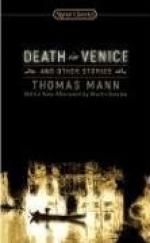|
This section contains 911 words (approx. 3 pages at 400 words per page) |

|
In the following essay, Bergenholtz suggests that Death in Venice is a parody of tragedy, citing the novel's focus on Aschenbach's "bathetic decline and fall" as evidence.
Gustave von Aschenbach, the protagonist of Thomas Mann's Death in Venice (1912), is whether or not he is a tragic character. Like numerous critics, Erich Heller argues that he is, and describes the novella as the "tragic story of Aschenbach's disillusion and downfall." In sharp contrast, Martin Travers insists that "it is not on a note of exaltation that Aschenbach is granted his exit, but rather on one of banality. . . . It is not the noble genre of tragedy but that hybrid form of doubtful status, tragicomedy, that provides the medium for his valediction." I would go further and argue that Mann presents us with a parody of tragedy, which satirizes the romantic assumptions that enable such an exalted view of humankind...
|
This section contains 911 words (approx. 3 pages at 400 words per page) |

|




